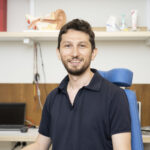Lien vers Pubmed [PMID] – 36115220
Lien DOI – 10.1016/j.jns.2022.120407
J Neurol Sci 2022 Nov; 442(): 120407
Periodic alternating nystagmus (PAN) is a rare oscillatory ocular motor disorder. The effects of gravity on the dynamic behavior of PAN can be studied by monitoring the nystagmus while changing head orientation. Previous studies of patients with PAN reached different conclusions about the effect of changing the orientation of the head relative to gravity on the ongoing PAN, either no effect or a damping of the nystagmus within several minutes. What neuronal circuits could account for the difference in the effects of gravity among PAN patients? We modeled how the brain resolves the tilt-translation ambiguity in normal individuals and added an unstable, oscillatory vestibular system generating PAN. PAN was suppressed in our patient in ear-down positions, in a similar pattern to that of a previously reported patient. This effect was simulated by reducing the gain of the projection of the “rotation feedback” loop to the velocity-storage integrator to approximately 5% of its normal value. With normal “rotation feedback” PAN is expected to dissipate quickly as soon as the head is rotated away from upright position. Moreover, by disconnecting the rotation feedback completely (gain = zero) the model simulated PAN that was reported to be unaffected by gravity. Thus, understanding the effect of this single parameter, the gain of the rotation feedback, can explain the observed variability among our own and previous studies.
